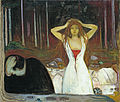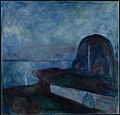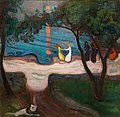Life frieze
The life frieze ( Norwegian Livsfrisen ) is a compilation of central works by the Norwegian painter Edvard Munch , most of which were created in the 1890s. Munch described the frieze as a “poetry about life, love and death”, which is how he named the central themes of his work. The life frieze does not include a clearly definable number of works. Munch painted many motifs several times, and the resulting pictures cannot be combined in size, shape and motif into a uniform cycle. Rather, the term, which was only established in 1918, is a title for various combinations of images that Munch made since 1893. Over time, the motifs expanded from the original theme of "love" to all aspects of human life.
development
Study for a series "Love"
In a text from 1918, in which he first coined the term frieze of life for the compilation of his central works, Munch stated that the first notes on the idea of such a cycle of pictures went back to the 1880s. He exhibited his frieze for the first time in 1892 in Kristiania, today's Oslo . However, the statements cannot be substantiated. The first documented compilation of six paintings under the title Study for a series “Die Liebe” took place in December 1893 in Berlin in a rented exhibition space on Unter den Linden . They were The Voice , The Kiss , Vampire , Madonna , Melancholy and The Scream . According to Hans Dieter Huber , the order of the pictures tells a story of love, from the attraction of the sexes on a summer night, a kiss and the robbery of the man’s strength to the shining of the woman in full bloom and the sinking of the man into melancholy to final fear of life is enough.
The Voice (1893), Museum of Fine Arts, Boston
The Kiss (1892), Norwegian National Gallery , Oslo
Vampire (1893), Art Museum, Gothenburg
Madonna (1894–95), Norwegian National Gallery , Oslo
Melancholy (1892), Norwegian National Gallery , Oslo
The Scream (1893), Norwegian National Gallery , Oslo
Studies on a series of moods "Love"
In October 1894, Edvard Munch's largest solo exhibition to date was held at the Stockholm Art Association. He presented his works in a total of five sections, the last of which was entitled Studies on a series of moods “Love” . In it he exhibited 14 paintings and a vignette based on the motif melancholy , which Munch had designed for his friend Emanuel Goldstein's collection of poems Alruner . He lets the story of love begin in nature, it still ends with the scream . Some motifs are doubled and thus varied for the viewer, which breaks through the linearity of the picture narration. Newly added to the series are the images The Woman in Three Stages , Ashes , Metabolism , Hands , Starry Night , The Girl and Death , Eye to Eye and Fear .
Ashes (1895), Norwegian National Gallery , Oslo
Hands (1893), Munch Museum Oslo
Starry Night (1893), The J. Paul Getty Museum , Los Angeles
Angst (1894), Munch Museum Oslo
Separation (1896), Munch Museum Oslo
In March 1895, at another exhibition in Berlin, the cycle under the title Series: Die Liebe (1–14) still consists of 14 pictures. The order is now: Strandmystik , The Voice , The Kiss , Vampire , two versions of Madonna and The Woman in three stages , Separation , The Hands , two versions of Melancholy followed by Despair and The Scream .
Representation of a series of images of life
Munch first used the word “frieze” instead of “series” in 1902 at the fifth exhibition of the Berlin Secession , where he gave him the title Fries (in the sculpture hall). Representation of a series of life pictures an entire hall is made available for his pictures. Corresponding to the four walls of the room, Munch divides a total of 22 works into four sections:
- Germination of love : starry night , red and white , eye to eye , dance on the beach , the kiss , Madonna
- Flowering and passing of love : ashes , vampire , the dance of life , jealousy , the woman in three stages , melancholy
- Fear of life : fear , evening on Karl Johans gate , red wine , Golgotha , the scream
- Death : On the death bed , death in the sickroom , odor of corpses , metabolism , the child and death
According to Hans Dieter Huber, the sequence still suggests a linear narrative sequence that leads from the first meeting of man and woman, the budding and fading of their love to fear, despair, illness and death. Only with the biblical motif man and woman / metabolism will Munch begin to describe life as a cyclical cycle. The 1902 exhibition was the last major joint presentation of the frieze during Munch's lifetime before the collection was dispersed and dissolved through sales.
Red and White (1899–1900), Munch Museum Oslo
Dance on the Beach (1899–1900), National Gallery, Prague
The Dance of Life (1899–1900), Norwegian National Gallery , Oslo
Jealousy (1895), Bergen Art Museum
Evening on Karl Johans gate (1892), Bergen Art Museum
Red Wine (1898–1900), Munch Museum Oslo
Golgotha (1900), Munch Museum, Oslo
On his deathbed (1895), Bergen Art Museum
Death in the Sick Room (1893), Norwegian National Gallery , Oslo
Corpse Smell (1895), Munch Museum Oslo
Metabolism (1898–99), Munch Museum Oslo
The Child and Death (1899), Kunsthalle Bremen
concept
Painting as poetry
In his published text about the 1918 Frieze of Life Munch described: "The frieze is a seal on life, love and death." In fact, according to Matthias Arnold, the whole cycle "than in images transmitted seal are called." From the first to the last presentation of the frieze of life , the hanging of the pictures always demonstrated a clear narrative sequence; the exchange of the order reveals that Munch repeatedly struggled for positions in the narrative logic. Between 1894 and 1896 a text was written in which Munch himself explained his series of pictures with a story that described the “struggle between man and woman, called love”: “From its beginnings, where it is rejected ( voice )” via “kiss ( Kiss ), love ( eye to eye ) and pain, where the fight started ( ashes , vampire ) ”. The pictures showed the “painful beauty of a Madonna” ( Madonna ) and the woman as a multifaceted mystery ( The woman in three stages ). Her hair is wrapped around the man's heart ( separation ), he feels desire ( hands ), gets into a "sick mood ( fear ) - nature appears to him like a great scream, in it blood-red clouds like dripping blood ( The Scream )".
Munch's art was often referred to as “literary”, especially in France. The painter himself rejected this term, which he understood as a reproach, just as he defended himself against the derogatory label “thought painting”. However, he always protested against purely decorative art and drew a comparison with Cézanne : "I painted a still life just like Cézanne, only that I painted a murderess and her victim in the background." Elsewhere he compared himself with Leonardo da Vinci : “Just as Leonardo da Vinci studied the inside of the human body and dissected corpses - so I try to dissect the soul.” While in da Vinci's time autopsy of corpses was punishable, in Munch's presence it was “mental phenomena that is almost considered immoral and frivolous to dissect. ”His art, which was shaped by past experiences and inner moods, he reduced to the frequently quoted formula:“ I don't paint what I see - but what I saw. ”
A cycle of pictures as a frieze

In art history, a frieze is understood to be a strip-shaped wall element that is used for structuring or for decoration. It can consist of ornaments or figurative elements. Munch first referred to his picture cycle in 1902 as a “frieze”, which may be due to a suggestion from frescoes during his trip to Italy in 1899. However, the life frieze was created at a time when painting cycles were becoming popular with many artists. Vincent van Gogh dealt with this, as did Max Klinger and Gustav Klimt , who realized the Beethoven frieze in 1901 . Many painters, including Munch, were influenced by Puvis de Chavannes ' decorative tableaus .
Again and again the objection to Munch's life frieze was that his pictures were far too inconsistent in format and conception for a frieze. Munch countered such allegations: “I do not think that a frieze has to be monotonous. This often makes decorations and friezes so terribly boring. […] In my opinion, a frieze can have the effect of a symphony , rising up into the light, sinking into the depths. The effect of the symphony rises and falls. ”He also emphasized the connecting elements in the images of the life frieze : a continuous beach line, vertical (trees) and horizontal (beach) structures as well as uniformity in mood and color.
On the presentation of the frieze of life , Munch said in 1918: “According to my ideas, the frieze should be installed in a hall that provides a suitable architectural framework so that every picture would come into its own without affecting the overall impression. Unfortunately, no one has yet been ready to implement this plan. ”In his imagination, he designed an entire house that had several rooms so that each theme complex would have its own space,“ either as a frieze or as large wall panels ”, but with transitions with the remained connected to other rooms. Uwe M. Schneede reads both resignation and irony from Munch's final statement that the best exhibition space for his frieze of life is probably a castle in the air . Today, the images of the frieze of life are mostly distributed over three museums. Central works are presented by the Norwegian National Gallery and the Rasmus Meyer Collection in the Bergen Art Museum , while the majority of the estate is housed in the Munch Museum Oslo .
Later friezes
In the course of his later career, Munch was given several opportunities to implement the concept of a uniform picture cycle with new works. In 1903 the Lübeck doctor and art collector Max Linde commissioned him to design a decorative frieze for his four sons' nursery. The aim was to create images that were expressly suitable for children, which is why Munch limited his motifs to the first part of the life frieze , the germination of love , and especially the depiction of landscapes. The so-called Linde frieze comprised eleven pictures, all between 90 and 92 cm high, but varying in width from 30 to 315 cm. Linde rejected the pictures after they were completed, possibly because they were not as child-friendly as hoped.
Sunshine (1904), Munch Museum Oslo
Dance by the Sea (1904), Munch Museum Oslo
Lovers in the Park (1904), Munch Museum Oslo
Youth by the Sea (1904), Munch Museum Oslo
In 1906, Max Reinhardt , the director of the Deutsches Theater in Berlin, commissioned Munch to design a frieze for the ballroom of the newly founded chamber theater. Twelve pictures were created for the so-called Reinhardt frieze that spanned all four walls of the hall above eye level. While the motifs are taken from the frieze of life , Munch used a new technique: tempera on unprimed canvas . However, the hall only remained in the form designed by Munch until its renovation in 1912 and was rarely open to the public. After that, the pictures were sold and only 50 years later were mostly brought together again by the Neue Nationalgalerie in Berlin.
Melancholy (Reinhardt-Fries) (1906-07), Neue Nationalgalerie , Berlin
The Sun (1911), University of Oslo
Between 1914 and 1916, Munch equipped the auditorium of the University of Kristiania with a total of eleven large-format canvases. The front of the room is occupied by the painting The Sun , while the other paintings are related to each other in pairs, such as the allegorical figures in the main works The Story , an old man who passes on his knowledge to the younger generation, and Alma Mater , a mother in the middle of their children. In 1922 another twelve-painting frieze was created for the workers' canteen of the Freia chocolate factory in Kristiania, based on the motifs of the linden frieze. Another version of his life frieze for Oslo City Hall , which was newly built in the 1930s, occupied Munch from 1928 onwards, but did not get beyond the design stage.
literature
- Matthias Arnold: Edvard Munch . Rowohlt, Reinbek 1986. ISBN 3-499-50351-4 , pp. 42-53.
- Ulrich Bischoff : Edvard Munch . Taschen, Cologne 1988, ISBN 3-8228-0240-9 , pp. 31-63.
- Hans Dieter Huber : Edvard Munch. Dance of life . Reclam, Stuttgart 2013, ISBN 978-3-15-010937-3 , pp. 65-71.
- Uwe M. Schneede : Edvard Munch. The early masterpieces . Schirmer / Mosel, Munich 1988, ISBN 3-88814-277-6 , pp. 19-23.
Individual evidence
- ^ Hans Dieter Huber: Edvard Munch. Dance of life . Reclam, Stuttgart 2013, ISBN 978-3-15-010937-3 , pp. 65-66.
- ^ Hans Dieter Huber: Edvard Munch. Dance of life . Reclam, Stuttgart 2013, ISBN 978-3-15-010937-3 , p. 67.
- ^ Uwe M. Schneede: Edvard Munch. The early masterpieces . Schirmer / Mosel, Munich 1988, ISBN 3-88814-277-6 , p. 20.
- ^ Hans Dieter Huber: Edvard Munch. Dance of life . Reclam, Stuttgart 2013, ISBN 978-3-15-010937-3 , pp. 67-68.
- ^ Hans Dieter Huber: Edvard Munch. Dance of life . Reclam, Stuttgart 2013, ISBN 978-3-15-010937-3 , pp. 69-70.
- ^ Uwe M. Schneede: Edvard Munch. The early masterpieces . Schirmer / Mosel, Munich 1988, ISBN 3-88814-277-6 , pp. 20-21.
- ^ Quote from: Matthias Arnold: Edvard Munch . Rowohlt, Reinbek 1986. ISBN 3-499-50351-4 , p. 43.
- ^ A b Matthias Arnold: Edvard Munch . Rowohlt, Reinbek 1986. ISBN 3-499-50351-4 , p. 42.
- ^ Hans Dieter Huber: Edvard Munch. Dance of life . Reclam, Stuttgart 2013, ISBN 978-3-15-010937-3 , pp. 68-69.
- ↑ Quotations from: Uwe M. Schneede: Edvard Munch. The early masterpieces . Schirmer / Mosel, Munich 1988, ISBN 3-88814-277-6 , p. 21.
- ^ Uwe M. Schneede: Edvard Munch. The early masterpieces . Schirmer / Mosel, Munich 1988, ISBN 3-88814-277-6 , p. 19.
- ↑ Quoted from: Uwe M. Schneede: Edvard Munch. The early masterpieces . Schirmer / Mosel, Munich 1988, ISBN 3-88814-277-6 , p. 13.
- ^ Hans Dieter Huber: Edvard Munch. Dance of life . Reclam, Stuttgart 2013, ISBN 978-3-15-010937-3 , p. 68.
- ^ Uwe M. Schneede: Edvard Munch. The early masterpieces . Schirmer / Mosel, Munich 1988, ISBN 3-88814-277-6 , p. 21.
- ^ Matthias Arnold: Edvard Munch . Rowohlt, Reinbek 1986. ISBN 3-499-50351-4 , p. 52.
- ^ Uwe M. Schneede: Edvard Munch. The early masterpieces . Schirmer / Mosel, Munich 1988, ISBN 3-88814-277-6 , p. 22.
- ^ Uwe M. Schneede: Edvard Munch. The early masterpieces . Schirmer / Mosel, Munich 1988, ISBN 3-88814-277-6 , pp. 21-22.
- ^ Matthias Arnold: Edvard Munch . Rowohlt, Reinbek 1986. ISBN 3-499-50351-4 , p. 53.
- ^ Ulrich Bischoff: Edvard Munch . Taschen, Cologne 1988, ISBN 3-8228-0240-9 , pp. 57-60.
- ^ Ulrich Bischoff: Edvard Munch . Taschen, Cologne 1988, ISBN 3-8228-0240-9 , pp. 60-62.
- ^ Ulrich Bischoff: Edvard Munch . Taschen, Cologne 1988, ISBN 3-8228-0240-9 , pp. 62-63.






























